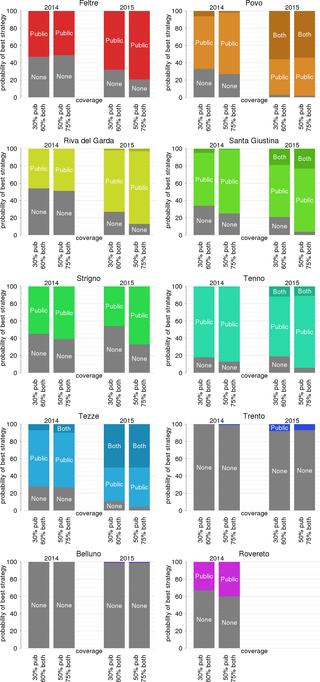PLOS Neglected Tropical Diseases ( IF 3.8 ) Pub Date : 2017-09-11 , DOI: 10.1371/journal.pntd.0005918 Giorgio Guzzetta 1 , Filippo Trentini 2 , Piero Poletti 1, 2 , Frederic Alexandre Baldacchino 3 , Fabrizio Montarsi 4 , Gioia Capelli 4 , Annapaola Rizzoli 3 , Roberto Rosà 3 , Stefano Merler 1 , Alessia Melegaro 2, 5

|
In the last decades, several European countries where arboviral infections are not endemic have faced outbreaks of diseases such as chikungunya and dengue, initially introduced by infectious travellers from tropical endemic areas and then spread locally via mosquito bites. To keep in check the epidemiological risk, interventions targeted to control vector abundance can be implemented by local authorities. We assessed the epidemiological effectiveness and economic costs and benefits of routine larviciding in European towns with temperate climate, using a mathematical model of Aedes albopictus populations and viral transmission, calibrated on entomological surveillance data collected from ten municipalities in Northern Italy during 2014 and 2015.We found that routine larviciding of public catch basins can limit both the risk of autochthonous transmission and the size of potential epidemics. Ideal larvicide interventions should be timed in such a way to cover the month of July. Optimally timed larviciding can reduce locally transmitted cases of chikungunya by 20% - 33% for a single application (dengue: 18–22%) and up to 43% - 65% if treatment is repeated four times throughout the season (dengue: 31–51%). In larger municipalities (>35,000 inhabitants), the cost of comprehensive larviciding over the whole urban area overcomes potential health benefits related to preventing cases of disease, suggesting the adoption of more localized interventions. Small/medium sized towns with high mosquito abundance will likely have a positive cost-benefit balance. Involvement of private citizens in routine larviciding activities further reduces transmission risks but with disproportionate costs of intervention. International travels and the incidence of mosquito-borne diseases are increasing worldwide, exposing a growing number of European citizens to higher risks of potential outbreaks. Results from this study may support the planning and timing of interventions aimed to reduce the probability of autochthonous transmission as well as the nuisance for local populations living in temperate areas of Europe.
中文翻译:

欧洲温带城市环境中常规杀幼虫预防基孔肯雅热和登革热的有效性和经济评估
在过去的几十年里,一些虫媒病毒感染并未流行的欧洲国家面临着基孔肯雅热和登革热等疾病的爆发,这些疾病最初是由来自热带流行地区的传染性旅行者引入的,然后通过蚊虫叮咬在当地传播。为了控制流行病学风险,地方当局可以实施旨在控制病媒丰度的干预措施。我们使用白纹伊蚊种群和病毒传播的数学模型,根据 2014 年和 2015 年从意大利北部 10 个城市收集的昆虫学监测数据进行校准,评估了气候温和的欧洲城镇常规杀幼虫的流行病学有效性以及经济成本和效益。发现对公共集水池进行常规杀幼虫可以限制本地传播的风险和潜在流行病的规模。理想的杀幼虫干预措施的时间安排应覆盖整个七月。最佳杀幼虫时间一次施用可将基孔肯雅热局部传播病例减少 20% - 33%(登革热:18-22%),如果在整个季节重复治疗四次,则可减少高达 43% - 65%(登革热:31-22%)。 51%)。在较大的城市(超过 35,000 名居民),整个城市地区全面杀幼虫的成本克服了与预防疾病病例相关的潜在健康效益,这表明应采取更局部的干预措施。蚊子丰富度高的中小城镇可能会实现积极的成本效益平衡。普通公民参与常规杀幼虫活动进一步降低了传播风险,但干预成本不成比例。全球范围内的国际旅行和蚊媒疾病的发病率正在增加,使越来越多的欧洲公民面临潜在疫情爆发的更高风险。这项研究的结果可能支持旨在减少本土传播可能性以及对欧洲温带地区当地居民造成的滋扰的干预措施的规划和时机。


























 京公网安备 11010802027423号
京公网安备 11010802027423号